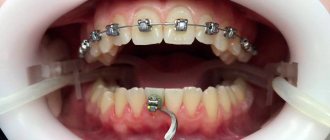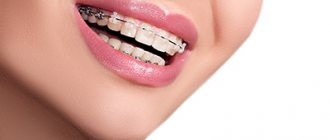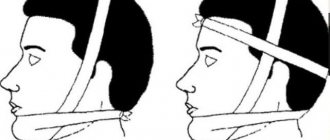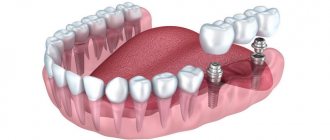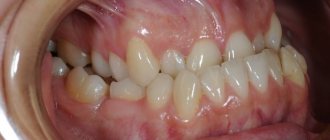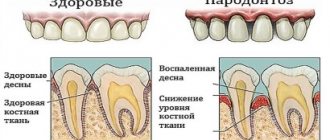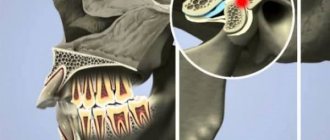A deep bite is a developmental anomaly of the oral cavity in which the upper incisors almost completely overlap the lower ones. It not only distorts the proportions of the face, but can also cause speech disorders, increased tooth wear and trauma to soft tissues. Pathology can be detected both in early childhood and in adulthood. Treatment depends on the severity, but most often involves braces, plates, or orthodontic surgery.
Manifestations of distal bite in the mouth
Closing of lateral teeth during distal occlusion.
Distal occlusion is manifested in the mouth by the closure of the upper and lower teeth according to the “second class” (violation of the relationship between the projections of the antagonist teeth of the upper and lower jaw).
In the frontal segment (at the level of the front teeth) there are two closure options (the so-called first or second subclasses).
In the first case, a “sagittal gap” is observed, which reflects the discrepancy between the dentition in the sagittal plane (anterior-posterior direction). And the upper incisors are in protrusion (inclined forward). In the second option, the upper front teeth are tilted back (into retrusion). With the formation of a deep bite (when the lower teeth are not visible from under the upper ones).
Sagittal chain with distal occlusion. 2 class 1 subclass.
Distal occlusion. 2nd class 2nd subclass.
What happens if you don't correct a deep bite?
Complications of uncorrected deep bite:
- loosening of incisors,
- cracks and chips on the front teeth,
- abnormally rapid and uneven wear of enamel (especially lateral teeth),
- sensitivity of the anterior incisors to cold and food,
- gradual protrusion of the upper incisors,
- wedge-shaped defects.
Such defects appear due to the strong pressure of the lower front teeth on the upper palate.
There are also complications that do not directly affect the condition of the teeth:
- Trauma to the mucous membrane of the palate.
Constant friction of the lower incisors against the upper palate provokes persistent wounds. But the mucous membrane must constantly renew itself, which is why an excessive number of new cells appear. This, in turn, increases the risk of mutations and cancer.
- Disorders of the temporomandibular joint.
The patient can move the jaw limitedly, the muscles are stiff. People often experience pain in this area, hear crunching or clicking noises when chewing, and suffer from migraines. If this is not corrected, over time the patient will experience degenerative processes in the joint.
Causes of distal bite (distal occlusion)
They are almost always (in the vast majority of cases) skeletal...
- Posterior position of the lower jaw. This is the most common cause of distal occlusion
- Small (short) lower jaw.
Many people write that the cause of a distal bite may be an overdeveloped (excessively large) upper jaw. They say that this is why there is a “gap” between the front upper and lower teeth (sagittal gap)... Many years of observations and our experience have shown that this is not so. With any anomaly of occlusion, there can be no talk of any OVERdevelopment. Everything, on the contrary, is UNDERdeveloped.
The lower jaw ends up in a posterior position (the first reason) only because the lower teeth bump into the upper teeth while the upper jaw is shortened and narrowed (generally underdeveloped). Or, when the upper incisors are “wrapped” back, into retrusion (second subclass). In addition, with distal occlusion, the upper jaw is always narrower than the lower jaw. Which, by the way, is another reason for blocking the lower jaw in the posterior position. And this same “blocking” does not allow the lower jaw, which is caught in the trap, to develop normally. Here is the second reason for distal occlusion - underdevelopment of the lower jaw.
There is also a “dental” reason for distal occlusion. Or more precisely, the dental cause of closure is “second class”. This is when mesial (front) displacement of the upper lateral teeth occurs. And then, even with a normal relationship of the jaws in the sagittal plane, the closure of the lateral teeth (molars) will also be in the second class. True, this is not a true distal occlusion...
A “dental” cause of the second class may complement or may camouflage true distal occlusion. Therefore, it will not be possible to figure out what is the reason for the closure in class 2 visually (by eye). Diagnostics required.
Prevention methods
Parents can prevent malocclusion in their child if they take care of their oral health and visit a specialist once every six months.
Habits that should alert a parent:
- sitting, the child constantly props up the same cheek with his hand;
- often touches growing teeth with tongue or hands;
- asymmetrical arrangement of the jaws.
Sleeping on the wrong pillow can be harmful: too high or low. This leads to curvature of the spine and malocclusion.
Only a doctor can make an accurate diagnosis. If you see the listed signs in your baby, visit the Russdent clinic. Our specialists will quickly and painlessly carry out a competent diagnosis and choose a strategy for further work with the patient.
Treatment at Russdent
Our clinic employs the best doctors who have extensive experience and constantly improve their skills through training. In addition, the clinic has modern equipment, which is important for early diagnosis. We use up-to-date treatment methods that provide high effectiveness even in difficult cases. These are the American systems “Damon Q”, “Damon Clear”, “H4”, as well as the lingual systems “Win” (Germany), “Incognito” (USA). For soft correction, transparent Invisalign aligners are used.
For more detailed information, please contact the clinic for a consultation.
Diagnostics
The main goal of any diagnosis is to identify the cause of the problem. And make a diagnosis. Likewise, the diagnosis of distal occlusion is designed to identify the cause of closure in the second class. In order to separate the flies from the cutlets during treatment, so to speak. That is, dental causes of closure are in the second class from non-dental (maxillary, skeletal).
The main diagnostic methods are:
- Analysis of TRG (teleradiogram) of the skull in a lateral projection. It allows you to clearly determine all the skeletal (jaw) nuances of the problem. Both with the position of the jaws and with their sizes.
- Analysis of plaster models of jaws (for this, casts are taken). It allows you to clarify the “dental” nuances: the size of the teeth, the length and width of the dentition, the features of the relationship (including closure) of the upper and lower teeth
Analysis of TRG (teleradiogram) of the skull in a lateral projection.
Analysis of plaster models of jaws.
It is not recommended to fall below this diagnostic “bar”. Below - just by eye. But this, as we understand, is not the best option.
Diagnostics is the first and key step in the treatment of distal occlusion. Do you want to know why it’s impossible to do without diagnostics?
Crossbite
The development of technology has led to a significant improvement in the living conditions of modern man. Unlike our ancestors, we do not have to eat rough, poorly prepared food. But this had its own impact on the formation of the skeleton, skull and muscular frame. Instead of teeth that fit evenly and tightly to each other, various violations often begin to occur: incomplete closure, crowding. Every second person faces problems in the field of orthodontics, in this article we will look at one of them.
When is crossbite diagnosed?
This deviation from the norm, in which the lower dentition overlaps the upper one, can touch either one tooth or several located nearby. It is quite rare, occurring in approximately 2% of all those who consult an orthodontist. Fixing this problem is a rather lengthy and labor-intensive process. Sometimes only surgery can help.
Etiology
The reasons can be varied, often it is a complex of factors and one “culprit” cannot be named. But there are still some signs that you should pay more attention to.
In our practice, the problem most often arises due to:
- underdevelopment of the skull bones as a result of difficulty in nasal breathing, lack of calcium, hereditary predisposition;
- uneven wear of the primary fangs, which do not fit tightly together and slide to the side, forming an incorrect position;
- premature loss of milk, due to which the rest are displaced, and the molars grow crooked and do not close well;
- bad habits - the child sucks a finger or a pacifier, constantly touches growing teeth with his tongue;
- facial injuries or unsuccessful prosthetics.
During childhood, it is important to visit the dentist once every six months. This will allow you to detect changes in time and adjust the process. In such situations, you can get by with simple procedures. For example, by filing fangs.
Types of occlusion
Orthodontists use the following classification:
- Depending on the location: side, front, scissors. In the latter case, the bottom row completely overlaps the top.
- Depending on the overlap: buccal - the large lower jaw overlaps the upper and lingual, when the opposite happens.
- Depending on the distribution: it refers to a certain area or concerns the entire oral cavity.
Overlapping can occur due to too massive or, conversely, underdeveloped facial bones.
Most orthodontists use this division:
- Buccal – can be unilateral or bilateral. Most often, the reason is an overly mobile and developed lower jaw.
- Lingual – contact between the teeth may be partial or completely absent. A typical reason is that one jaw is too short or too long.
- Buccal-lingual - there are signs of two types of occlusion, this case is considered the most difficult. It, in turn, can be dentoalveolar, articular or gnathic.
In addition, occlusion can be true, i.e. due to physiological characteristics, or false, i.e. caused artificially due to unconscious bad habits.
How to recognize
Experts advise contacting an orthodontist if the following signs appear:
if you notice that the closure is uneven;
if you find facial asymmetry when the chin is slightly shifted to the side;
if you feel discomfort while eating or speaking.
Since the curvature occurs gradually, a person may not notice it and get used to it. It is important to undergo regular preventive examinations, especially for young patients. The sooner you start therapy, the more effective it will be.
How to fix
The correction is selected individually, depending on the specific case.
Stages of development of the disorder:
Dentoalveolar – the initial stage. It differs in that the deviation from the norm concerns exclusively the teeth. The jaw apparatus itself has not yet undergone deformation. If measures are not taken at this moment, more serious pathologies will begin.
Skeletal – at this stage bone deformation occurs. The distorted position is fixed and maintained by the jaw apparatus itself. Skeletal occlusion is also possible due to uneven growth of bone tissue.
The latter form is easy to identify visually. It is enough to visually examine the oral cavity. If the jaw rows are clearly above each other, then this is still the dentoalveolar stage. If asymmetry has already affected the face, then the patient is at the skeletal stage.
If you do not contact the orthodontist on time
We recommend starting correction as early as possible, because its absence leads to a deterioration in a person’s quality of life:
- curvature at the dental level moves to the skeletal level;
- permanent ones begin to grow incorrectly;
- skeletal changes can lead to joint problems and poor posture.
- The following symptoms appear and intensify:
- uneven abrasion;
- damage to the enamel, the appearance of cracks at the base;
- gum tissue decreases, recession occurs, mucous membranes are often injured;
- caries, which is caused by excessive load on certain areas;
- When opening and closing the mouth, clicks are heard, pain appears, which then moves to the cervical region, and pain in the temples is not uncommon.
Of course, each person has his own clinical picture, a unique process of pathology development. While some will suffer only from aesthetic defects, others will suffer from headaches.
How does the correction work?
This will depend on the stage of development of the disease, the causes of its occurrence and age. The first stage is diagnosis. In addition to visual examination, our dentistry performs the following procedures:
- an orthopantomogram makes it possible to assess asymmetry at the bone level,
- A teleroentgenogram determines the condition of the skull bones.
Sometimes an x-ray may be needed:
- brushes for determining bone age in children,
- TMJ to detect deviations of the maxillotemporal joints.
We use modern and reliable equipment that allows us to detect the slightest changes in bones and joints, correctly diagnose and prescribe effective therapy. The strategy for children aged 5 to 12 years will be different from that for adolescents and adults.
Correction in children
Due to the softness of the tissues and the early stage of pathology in children, it is easier to correct occlusion. Most often, our doctors use orthodontic plates and devices for training and shaping the correct position of organs. In some cases, grinding of primary canines is appropriate. Classes with a speech therapist and exercises are also recommended. The list of recommendations is selected individually. Russdent also practices more modern methods, for example, wearing aligners. They can be transparent or colored, so the child uses them with pleasure, and correction does not cause pain.
Strategy for adults
In adults, more radical treatment of occlusion. It depends on the nature of the pathology. If skeletal changes occur, surgical intervention will be required. Sometimes orthodontic surgeons perform a series of surgeries to help change the size of your jaw. After this, they begin to correct it with braces.
Usually, with a little neglect, you can get by with aligners or a brace system. At the same time, exercises or wearing a joint splint may be recommended to bring the jaw into the correct position.
If the patient refuses or is prohibited from surgical interventions, the correction will be incomplete. After correction, it is important to regularly visit the orthodontist, who will monitor and quickly detect a possible relapse.
Errors in the treatment of distal occlusion
The first, main mistake is that many try to treat distal bite with one device. For example, only with braces (this is the most popular option). But braces, although a cool device, are not for skeletal problems. The level of hardware competence of the braces system does not extend further than “to place the teeth on the jaw.” And distal occlusion, as we have already said, is a purely skeletal problem. Jaws and posture are to blame. And braces are not capable of solving problems with posture or jaw problems. After all, braces cannot change the position or size of the jaw. No matter what the would-be doctors promise...
And therefore, such videos are just an advertising gimmick.
Or rather, a convenient “hook” that catches gullible patients. Convenient because it coincides with the desire to do everything quickly and efficiently... But it doesn’t coincide with reality.
And braces cannot be the main device in the treatment of distal occlusion.
Braces are the wrong choice when treating distal malocclusions. In any case, you definitely shouldn’t start with them. Braces, as mentioned and shown above, can be effectively used only at the final stage of treatment of distal occlusion. All major “feats” must be accomplished before working on the teeth. Before using braces. And they are accomplished at the level of the jaws and skeleton (posture). Otherwise, there will simply be nothing to “clog” (close) these teeth (read with braces). See “Fundamentals of the therapeutic concept of “Ortho-Arteli”.
The second common mistake in correcting distal occlusion is treatment with the removal of upper premolars (4 or 5 teeth).
And this mistake is much more serious. Because it can have the most dire consequences. See "Orthodontic treatment with tooth extraction."
After all, as we said above, the main causes of distal occlusion are skeletal. And most often the lower jaw is to blame. And if so, then a reasonable question arises: if the lower jaw is to blame, what does the upper teeth have to do with it (their removal). Where is the logic?
In general, all errors in the treatment of distal occlusion in an adult are usually associated with insufficient diagnosis. Which entails a misunderstanding of the reasons for the occurrence of distal occlusion in each specific case.
For example, the “dental” cause of distal occlusion is very often confused with the “skeletal” (jaw) cause. We remind you that in the first case you need to move the lateral teeth back. And in the second - to push the lower jaw forward and develop the upper one. And if you get confused, if you don’t figure it out... Start distalizing the upper teeth, or worse, remove them when it is necessary to advance the lower jaw... Or vice versa. It is clear that nothing good will come of it.
The third mistake is when, without understanding what’s what, what exactly is the cause of distal occlusion, but realizing, however, that the problem cannot be corrected with braces, they try to solve the problem surgically. Using orthognathic surgery. Through osteotomy of the lower and upper jaws.
This is where I would like to dwell in more detail. And explain something. Why do orthodontists send to a surgeon to “treat” a distal bite? They have already said: they understand that braces will not cope. But they don’t understand how to treat it without braces. They don’t understand because in dentistry in general, and orthodontics in particular, there are a lot of prejudices regarding the possibilities of moving the lower jaw forward and developing the upper jaw. And these, as we saw above, are the main (“key”) points in the treatment of distal occlusion.
Most orthodontists simply do not believe in this (that it is possible in principle). Because someone (even a “great one”) said two hundred years ago that this cannot be done. Time has passed. Everyone has already forgotten why it is “impossible”. But no one even bothered to check why, in fact, it was impossible...
And therefore, those doctors who blindly believe in these moss-covered “dogmas” simply do not see an alternative. And for them there are only two extreme poles in the treatment of distal occlusion: braces and surgery. That's all.
During a direct examination by a specialist, you will be able to find out your exact diagnosis, as well as receive a referral for diagnosis or a treatment plan.
And in our clinic we treat distal occlusion between these two poles. Using methods of maxillofacial orthopedics and craniodontics. Here are the ones: changing the position of the lower jaw and changing the size of the upper. And we get good results, without regard to the fact that someone once said something... We must always double-check what was said. We checked. And everything turned out to be somewhat different. Or rather, not at all the way they “frightened” us. You can also push it out. It can be developed. You just need to know how, because there are some “secrets” here. And we, at the Orto-Artel clinic, knowing these “secrets”, take advantage of these opportunities, successfully eliminating distal occlusion of any complexity.
By the way, if we are talking about surgical treatment of distal occlusion, then we need to determine when and in what cases surgery is generally appropriate. But the indication is basically the same - a small lower jaw, the so-called lower micrognathia, and the micrognathia is very pronounced.
We indicated this reason above as one of the skeletal reasons. I will add: the lower jaw should be VERY short. Literally ugly. Only then can this be resolved surgically. In all other cases, you can do without surgery. Proven and tested many times.
By the way... In our clinic, a good half of the patients have formal indications for surgical treatment of distal occlusion. But only a few got to the surgeon. Because formalities are formalities, but compromise solutions were found that satisfied everyone: both the patients and us. This is because we approach treatment not formally, but in essence. And we are guided by logic and common sense.
Well, as a special case of a short lower jaw, which cannot be corrected except by surgery, this is a small chin. If it is small and spoils the face, then even by pushing the lower jaw forward we will not get the aesthetics we want. Simply because orthodontists do not have the means and instruments (devices) to selectively influence the chin. It is impossible to stimulate the chin to grow. Only surgery.
Inferior micrognathia.
This is where the indications (and there is essentially one) for surgical intervention for distal occlusion end.
Going with a knife into the upper jaw - God forbid! Even if the upper jaw is indirectly to blame for the distal occlusion. More precisely, the upper jaw also, as a rule, suffers (dimensionally) with distal occlusion. The upper jaw is directly connected to the base of the skull. And such interventions can then backfire. Literally. And the most important thing is that there is no need to go there surgically. The upper jaw can be developed!!!
How to correct a protruding jaw?
It is possible to correct a protruding upper or lower jaw, but it is worth keeping in mind that this is a long process that will require time and effort. The easiest way to correct a protruding jaw is in childhood: bones that are in the process of growth are easier to manipulate. In adults, correction of the mesial bite can take several years.
All treatment methods can be divided into three categories.
Gentle treatment - mainly used to correct protruding jaws in children under 12-13 years of age. As a rule, it involves inhibiting the growth of one of the jaws and stimulating the development of the other.
- Massaging the bone of the alveolar ridge is a stimulating effect that accelerates the development of the jaw.
- Wearing orthodontic structures - mouthguards, braces and trainers. Removable structures (trainers or LM activators) are effective starting from the period of primary occlusion. They can be used in the preparatory period before installing braces, thereby reducing the time of orthodontic treatment.
- Myofunctional gymnastics aimed at training the facial muscles. Orthodontists recommend starting to do such exercises for children from 2.5 to 3 years old, which will normalize maxillofacial development.
- Using vestibular plates to combat bad habits. Such techniques are used for primary and mixed dentition (aged 3 to 9 years), they are necessary to eliminate myofunctional disorders in the growing body. At the same time, the effectiveness of the exercises significantly increases (daytime training for 1 - 2 hours and wearing the device at night).
Orthodontic treatment
- This is a gradual correction of the position of the jaw using special devices that must be worn every day for a certain time (or constantly). In addition to the well-known brace systems (read more about braces in the article), more complex designs can be used. They change the direction of bone growth, pull the “lagging” jaw forward, expand the dentition, align and move teeth in the right direction. There are intraoral and extraoral systems. They are quite effective, but wearing them is associated with certain restrictions.
Surgical treatment
— surgical correction of a protruded jaw.
- Plastic surgery (trimming) of the frenulum of the tongue is prescribed for children 5-6 years old and can effectively correct the bite during the period of changing teeth.
- Tooth extraction helps reduce the size of an overdeveloped jaw.
- Osteotomy is a radical way to get rid of a protruding jaw. Prescribed to patients over 18 years of age when other methods are ineffective or have failed. During the operation, the jawbone is sawed, placed in the desired position and fixed with titanium structures. Read more about orthoganic surgery here.
